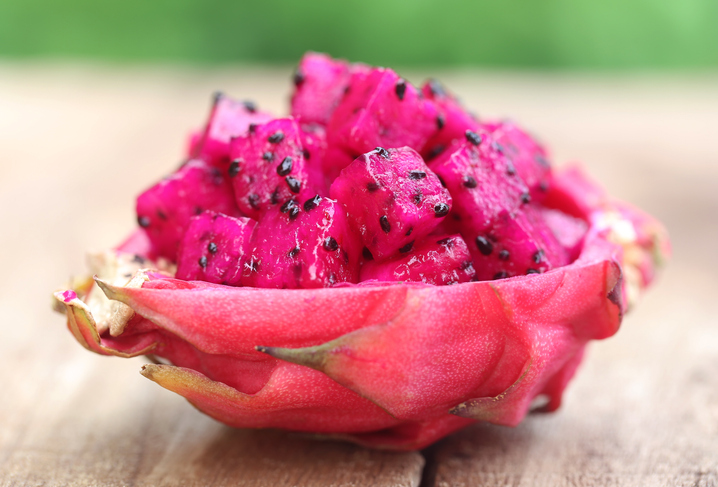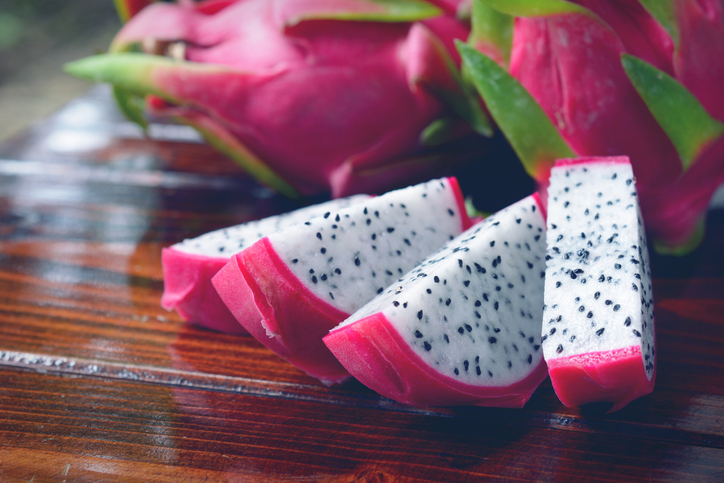If you’re looking to boost your tropical fruit knowledge base, check out dragon fruit.
Also known as pitaya or pitahaya, Dragon Fruits are leathery football-shaped fruits that come in three varieties: red skin with red flesh, red skin with white flesh, and yellow skin with white flesh.
From the outside, Dragon Fruits are colored pink and typically have green scales. These green scales are why they are named ‘dragon’. From the inside, the flesh is white and has tiny black seeds. This spotted look is what makes dragon fruit look, unlike any other fruit you have ever eaten.
Taste

The pink skin with the pink flesh variety is considered to be the best tasting. It tastes sweeter than the rest and is truly delightful. These are often called ‘Bloody Mary’ or ‘Red Jania.’
The pink skin with the white flesh is the most well-known kind and can be found in most places. It tastes sweet but not as sweet as the one with pink flesh.
The third variety has yellow skin and white flesh. This kind of dragon fruit is extremely hard to find. However, it is the sweetest of them all.
Dragon fruit is eaten by scooping out the flesh and cutting it up into bite-size pieces. You can eat it at room temperature but we suggest eating it cold as that is when it tastes the best.
Calories
A 100-gram serving of dragonfruit has 60 calories and 1 gram of fiber. Larger fruits may have up to 300-grams of edible flesh, rounding out to 180 calories and 3 grams of fiber per fruit.
Pricing
In the US, much of the dragon fruit is grown in Hawaii. It’s not cheap, however. Hawaiian dragon fruit on Kauai for $6.99/pound. At almost $5.00 for a piece of fruit, this is certainly a food enjoyed occasionally. Despite the high price tag, dragon fruit’s sweet and mild taste does make it a unique treat.
FAQ- Dragon Fruit: Tropical Fiber
1. Is dragon fruit a good source of fiber?
Yes, dragon fruit is an excellent source of fiber because it packs in a lot of fiber in itself.
It is estimated that dragon fruit has 7 grams of fiber within a 1 cup serving. This makes a whole dragon fruit have more than our daily requirement of fiber.
Adults require at least 25 grams of fiber a day so it is very well possible to gain all of that from a dragon fruit. Due to its high fiber content, this fruit is great for constipation and other gastrointestinal issues. Dragon fruit can also be beneficial for our cardiovascular health and in helping maintain our blood-sugar levels.
2. Are there any side effects to consuming Dragon fruit?
Every food has pros and cons. Dragon fruits are extremely healthy fruits that contain a lot of benefits. However, with those also come some side effects.
Side effects of Dragon fruit include stomach issues, reddish pee, allergic reactions. Some people have also claimed that dragon fruit causes hypotension.
Because dragon fruit contains a lot of fiber and antioxidants, it has the potential to mess with our gut and cause unwanted effects. Antioxidants when consumed in excess are also quite harmful.
Hence, it is wise to consume it in moderation and to not overeat any fruit. This includes dragon fruit.
3. Can we consume dragon fruit on an empty stomach?
Yes, you can eat dragon fruit on an empty stomach and not have any harmful side effects. Dragon fruit is well known for helping speed up our digestion and detoxifying the body at the same time. Hence, if you consume dragon fruit on an empty stomach, you can get rid of all the toxins.
Additionally, it is also packed with a lot of nutrients. So dragon fruit essentially takes out the toxins from your body and gives you the necessary nutrients that your body needs. Having dragon fruit for breakfast is thus a great idea.
4. Does dragon fruit have any vitamins?
Yes, dragon fruit is high in many vitamins such as vitamin C. It also has other antioxidants that are extremely beneficial for your immune system.
Dragon fruit is also known to have iron which helps give you energy and allows the oxygen in your body to travel better.
Hence, dragon fruit overall improves the blood-oxygen level of our body and provides us with iron and vitamin C.
Conclusion
With its gorgeous looks and sweet taste, dragon fruit is truly one of a kind. Even though it is a bit expensive as compared to other fruits, there is no doubt that it is not extremely beneficial for us. It looks good, tastes good, and is healthy. What more could one want from a fruit?

